Abstract
In the present study, using a combination of theoretical discussions, practical examples, and case studies, we sought to gain a comprehensive understanding of how numerical solutions could be used to improve the design and optimize the thermal efficiency of a heat exchanger that utilizes wastewater to reduce the domestic consumption of hot water. To this end, we developed a validated numerical model. We also carried out simulations and experiments, the results of which are presented in this paper. The novelty of this work derives from our use of a new heat exchanger design for a domestic shower, and from the presented experimental–numerical evidence that proves its efficiency. We found that use of our newly designed appliance improved thermal efficiency from 14% to 27%. Moreover, we estimated that the cost of manufacturing and installing such a device did not exceed that of a widely available drain grid. Using our newly designed exchanger, a family of four living in Poland could save EUR 38 (at 2022 values) and reduce CO2 emissions by 192 kg. An average European family could save EUR 68 and reduce CO2 emissions by 76 kg.
1. Introduction
The development of civilization is driven by population growth and urbanization. These processes require that energy sources be managed and conserved so that energy may be supplied to end-users in a sustainable way. In pursuit of this objective, heat exchangers may have an important role to play. Heat exchangers ensure high performance in processes such as wastewater heat recovery. Globally, according to Hervás-Blasco et al. [1], the building sector accounts for nearly 27% of total energy consumption. In Poland, as in other countries, energy efficiency in the building sector is a key aspect of sustainable development. Improved energy efficiency can be achieved by the better design of buildings, but improvements can also be attained when replacing everyday appliances.
As reported by Gereck et al. [2], energy consumption per square meter of domestic living space is now rising at a much faster rate than was assumed at the beginning of the 21st century. However, this rate of increase might be slowed by carrying out energy analyses of new buildings and by implementing innovations to reduce energy consumption.
The growing demand for electricity and heat has resulted in the rapid depletion of fossil fuels. If energy crises are to be avoided, governments and societies should focus their attention on developing renewable energy sources and heat-efficient appliances. For instance, the energy efficiency of buildings can be improved by recovering heat from wastewater [3]. Stec et al. [4] reported that the importance of unconventional solutions in this area is steadily growing. In addition, Prajapati et al. [5] stated that the recovery of energy from greywater is an effective method for reducing energy consumption and carbon emissions. Spriet et al. reported that the use of a greywater heat recovery system can result in a reduction in greenhouse-gas emissions [6]. According to Wong [7], 20% of the energy used by a typical household in Shanghai is used to heat water for hygiene purposes. Birben et al. [8] reported that 50–80% of household wastewater comes from sinks and showers, while Boano et al. [9] gave a figure of 49%. According to the Central Statistical Office in Poland, average annual hot-water consumption is 53 m3 for each Polish citizen, with a corresponding cost of PLN 956.45 (EUR 220) [10].
A number of heat recovery methods have been proposed by researchers. These range from domestic devices for use in showers [11] and dishwashers [12,13], to larger-scale devices for use in the sewer systems of office buildings [14] or apartment blocks [15]. Spriet and Hendrik [14] implemented recovery technology in the Brussels-Capital Region and successfully recovered 55 kWh of heat energy when the sewer flow was 5–60 m3/h, further indicating that up to 160 kWh could potentially be recovered. In addition, more centralized options, such as wastewater treatment plants for residential developments, have also been described in the literature [16,17,18]. However, for the present study, we sought to develop an energy recovery system for a single shower cubicle, taking into consideration both efficiency and convenience of use.
Two general types of heat exchangers can be distinguished: crossflow and parallel flow [19]. A parallel heat exchanger reaches its theoretical maximum limit when the temperatures of the incoming substances are perfectly mixed, so that both substances reach the same final temperature. This limits the theoretical maximum efficiency of an unlimited parallel-flow heat exchanger to 50% [19]. In the case of a counterflow heat exchanger, the theoretical maximum efficiency is 100%, although this is never attainable in practice. In practice, well-designed counterflow heat exchangers achieve efficiency levels of 90–95%. A common example of a crossflow heat exchanger is the automobile radiator [19]. The most popular design of shower heat exchangers involves vertical construction. The vertical placement of heat exchangers requires sufficient precipitation height; if there is insufficient precipitation height, a horizontal placement may be considered. Horizontal placement leads to lower efficiency compared to vertical placement; a reduction of 7 p.p. was reported by McNobbla et al. [3]. However, a horizontal placement may bring advantages in terms of convenience, as when a device is hidden under the cover of a linear sink.
Two patents for shower heat exchangers have been found and analyzed. The first is for a horizontal counterflow device which is placed under the floor of a shower cubicle and involves parallel pipes for the delivery of cold water [20]. The second involves the use of a counterflow horizontal heat exchanger built as a pipe-in-pipe design [21]. Below, we offer a comparison of proposed solutions which are most similar to that developed for the present study. The variation in efficiency levels results from the different conditions under which experiments were carried out and the different methods used for calculation. It can be seen that, in all the reviewed studies, the greater the difference between cold- and hot-water temperatures, the greater the efficiency of the exchanger, so that greater efficiency is achieved during colder months, as stated in the conclusion of the work by Deng [22], in which the duration of a typical shower was found to be 8 min and 30 s, and the efficiency of the heat exchanger was affected only in 1–2 percentage points.
Sidurian [23] obtained an efficiency level of 25% in tests with a flow rate of 9.5 L/min, but this rose to 30% when the flow rate was reduced to 6.5 L/min. It can be concluded, then, that efficiency decreases when the flow of water mass increases. It should be noted that some researchers have taken into consideration the fact that heat is transferred to the human body during a shower. This temperature drop was found to range from 2 to 5 °C by Wong et al. [7].
Different researchers have used different methods for efficiency calculation, and so it is difficult to compare published efficiency values. It can be seen from Table 1, for example, that Selcuk et al. [24] obtained a figure of 27%, Spriet et al. obtained a figure of 22% [6], and Ramadan et al. [25] obtained figures in a range from 32.2 to 50.4%.

Table 1.
Comparison of DWHRs.
The European standard EN 12831-3 [26] can be used for calculating certain parameters for heat exchangers; it also provides statistical values for water temperatures during showers, as well as mass flow rates. Given a temperature of 42 °C, a mass flow in a range of 7 to 9 L per minute, and a shower duration of 5 to 7 min [27], the average volume of used water ranges from 35 to 65 L [28].
Somewhat differently, Kordana [29] tested eight different vertical heat exchangers with mass flows of 6.5 L/min and 10.5 L/min and shower temperatures of 38–45 °C; under such conditions, a maximum efficiency of 17% was obtained. Wong [7] presented statistical data which indicated that a shower takes 12 min on average. Finally, Vaičiūnas [30] found that larger installations like those used in hotels and sport centers could achieve a thermal efficiency level as high as 50.4%.
Reviewing the studies just referenced, it should be noted that every analysis refers to different input data. For instance, Deng [22] described a high-efficiency heat exchanger, but its design was not presented in the paper. A review of similar papers suggests that the high efficiency described by Deng is probably a consequence of the very long microvanes used as wastewater pathways. Similar designs are widely used in clean-water installations. However, many variants may be considered using numerical analysis. The increasing availability of computers with powerful microprocessors has paved the way for the evolution of computational fluid dynamics (CFDs), which is now used by device designers [31]. As reported by M. M. A. Bhutta et al. [31], validated FEM models can now be used to determine optimal geometry, materials, and operating conditions. This method of design reduces time and economic costs, compared with analyses based exclusively on experimental findings [32]. Kharat et al. [33] conducted experiments to investigate heat transfer rates in a concentric helical coil heat exchanger, and to determine values for the heat transfer coefficient. They found that the heat transfer coefficient for a tube containing flue gas in a heat exchanger could be improved through the use of CFD simulation and experimental analysis. They examined the impacts of various operating variables, including tube diameter, coil diameter, and the gap between concentric coils. They found that the heat transfer coefficient was influenced by the tube diameter and the gap between coils. Specifically, they observed that the heat transfer coefficient decreased as the coil gap increased, but increased as the tube diameter increased.
2. Experimental Procedure
An interdisciplinary approach was adopted for the present study. First, a broad analysis of patent research, papers, and reports was carried out. Human needs and functionality were considered, market analysis was carried out, and a prototype was then designed. Experimental studies and numerical analyses were conducted to validate the model, and the prototype was then redesigned in light of experimental and numerical results.
Various data concerning shower conditions can be found in the literature. In the present study, to determine shower parameters, a survey was conducted by the authors. Over the course of a week, four people measured warm-water temperature during showers taken twice daily. A total of 56 sample measurements were thereby obtained, and 44 ± 2 °C was determined to be a warm shower temperature. In addition, the average time required for a shower was determined to be 7 ± 1 min.
For our experiments, a new facility was developed along with a newly constructed heat exchanger, test-bench hardware, and software. The body of the heat exchanger was a 1 mm aluminum sheet reinforced with an epoxy resin–glass fiber composite. Stainless-steel sheets were used as covers. The heat exchanger used soldered copper pipes of 8 mm diameter (Figure 1). The general dimensions of the device were 670 mm (length) by 130 mm (width) (Figure 2). The shower head, hydraulic pipelines, iron valves, mixer, and Teflon sealings were purchased from commercial suppliers.
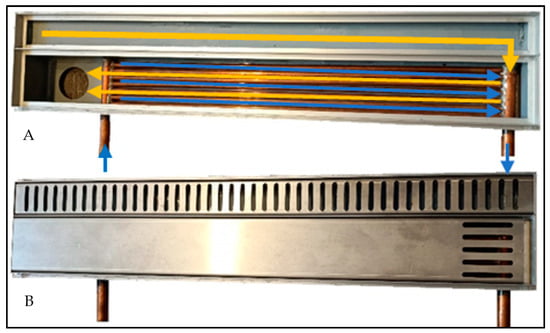
Figure 1.
(A) Interior of heat exchanger; cold water flow is marked with blue line and arrows, heated shower wastewater with orange lines; (B) outer case of heat exchanger with covers.
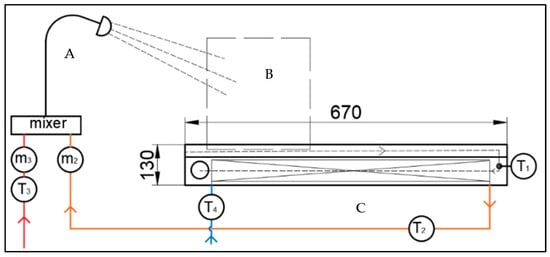
Figure 2.
Scheme of experiment [dimensions in mm]. Dimensions in mm are presented for general dimensions of outer case. m1, m2—flow measurement points; T1, T2, T3, T4—temperature measurements points; A—shower head; B—plate; C—heat exchanger; dashed line symbolizes streamlines of wastewater; orange line—heated water; red lines—hot water.
Measurements were made using an STM32F446RET6 microcontroller manufactured by STMicroelectronics, Maxim Integrated DS18B20 industrial thermocouples (accuracy 0.1 °C), a humidity and ambient-temperature sensor (accuracy 1 °C, humidity 3%), and flow meters (accuracy 0.2 L/min). In Figure 2, sensors are indicated by T1, T2, T3, T4, m2, and m3. A red color indicates hot water, orange indicates heated water (outflow of the heat exchanger), and blue indicates cold water. The dashed-line rectangle represents a plastic plate. T1 is the measured temperature of wastewater flowing into the heat exchanger. T2 is the measured temperature of heated water. T3 is the measured temperature of hot water. T4 is the measured temperature of cold water. m2 is the mass flow of heated water. m3 is the mass flow of hot water. m2,3 is the total mass flow. Finally, T2max is the measured maximum temperature of heated water exiting the heat exchanger during the test.
In the experiment, water flowing through the nozzles of the shower handset was directed from a distance of 300 mm onto a plastic plate with dimensions of 300 × 400 × 2 mm. The channel was fitted with covers. As water drained down the panel, it found its way into the channel. This was to replicate the natural conditions of (1) water splashing and (2) loss of heat through the stream. There were no blockages in the trough to slow down the flow of water used apart from one wall before the outflow. The angle between the exchanger and trough did not exceed 5°, so water had to continuously flow. This was assumed experimentally from a few repetitions of heat exchanger sets and observations of how the heat exchanger drained water. The longer the water stayed inside the heat exchanger, the greater the efficiency. However, this was limited by drainage parameters because of stagnation and soap deposits on the surface of the sink. Each of the three trials lasted 120 s. Three series of tests were conducted. The shower water temperature (T1) was 44 °C, and room temperature was 23 °C with 60% humidity.
Some of the parameters presented in Table 2 were used as boundary parameters in the CFD simulation.

Table 2.
Main parameters measured in experiment.
Experimental data are presented in the next chapter, where they are compared with data from the CFD analysis.
3. Theory and Calculations
In the pursuit of sustainable solutions which might be incorporated into the everyday lives of individuals, the integration of heat exchangers into the plumbing systems of households stands out as an example of innovation and improved efficiency.
The use of numerical solutions for use in the low-cost evaluation and optimization of multiple designs may play a potentially crucial role in the production of such systems. The Navier–Stokes equations were developed in the 19th century by Claude-Louis Navier and George Gabriel Stokes; these equations describe the behavior of flowing fluids and serve as the foundation of fluid dynamics. However, its analytical solutions have been found to be extremely challenging, especially in the case of more complex geometries. This has led to the development of numerical methods which have revolutionized fluid dynamics and resulted in more practical engineering solutions. These methods, which have been evolving for decades, include finite element methods, finite volume methods, and spectral methods; all involve the discretizing of domains, the application of appropriate numerical schemes, and the use of iteration to approximate flow fields.
In this paper, we review the fundamental principles and practical applications of numerical solutions in the context of household heat exchangers. Researchers have used computational fluid dynamics (CFDs) to simulate and analyze complex flow and heat-transfer phenomena within these innovative systems. The advanced algorithms and mathematical equations involved in numerical solutions enable users to explore various design configurations, optimize heat transfer efficiency, and assess performance under different operating conditions. In this paper, we also highlight the practical considerations and challenges encountered when numerical solutions are applied to household heat exchangers. These include mesh generation, boundary-condition specification, determination of convergence criteria, and validation techniques. Each step in the numerical simulation workflow demands careful attention if accurate and reliable results are to be obtained.
Through a combination of theoretical discussions, practical examples, and case studies, in this paper, we aim to provide a comprehensive understanding of how numerical solutions can empower the design and optimization of heat exchangers that utilize warm wastewater from showers. By harnessing the power of computation, we pave the way for more efficient, sustainable, and environmentally conscious household water heating systems; specifically, we focus on the design and optimization of heat exchangers that utilize wastewater to reduce household hot-water consumption.
ANSYS FLUENT 2023 R2 solvers are based on the finite volume method. The calculation domain is being discretized into a finite set of control volumes (Figure 3). General transport equations—Equation (1), are solved on this set of control volumes [34]:
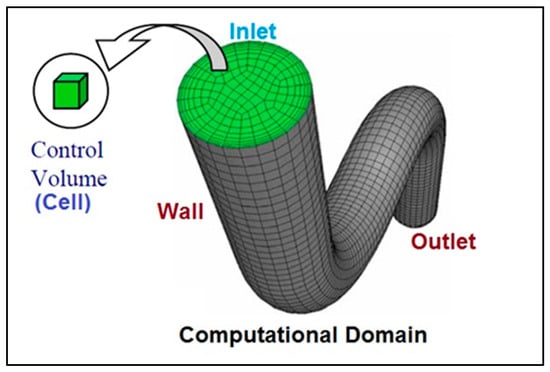
Figure 3.
Computational domain discretized into finite control volumes [35].
- -
- Continuity equation (conservation of mass);
- -
- Momentum equations (Newton’s second law);
- -
- Energy equation (conservation of energy).
- —parameter substituted for represents a different equation:
- -
- Continuity ;
- -
- X-Momentum (X-velocity);
- -
- Y-Momentum (Y-velocity);
- -
- Z-Momentum (Z-velocity);
- -
- Energy .
- —surface area;
- —density of liquid;
- —diffusion coefficient for ;
- —source of per unit volume;
- —time;
- —volume.
Partial differential equations may then be converted into a system of algebraic equations; these can be solved numerically to obtain a solution field.
Turbulence models in computational fluid dynamics (and also in ANSYS FLUENT) expand the governing Navier–Stokes equations for fluid flows to capture the effects of turbulence. These models introduce additional transport equations for turbulence quantities, and these equations may be solved at the same time as the continuity, momentum, and energy equations. Along with the LES (Large Eddy Simulation) and RSM (Reynold Stress Model), which are precise but computationally very expensive, two turbulence models have become well established in the field of inter-industrial problem solving: the k-ε and k-ω turbulence models. For the k-ε turbulence model, two additional equations are solved: for turbulent kinetic energy (k) and the rate of dissipation of turbulent kinetic energy (ε). These equations interact with the momentum and energy equations through turbulence production, dissipation, and viscosity.
The k-ω model is a popular choice for simulating turbulent flows, particularly in situations where accurate predictions of near-wall flow behavior are required. This model involves the solution of two additional transport equations: turbulent kinetic energy (k) and another specific rate of dissipation of turbulent kinetic energy (ω). Compared with the k-ε model, it provides better predictions for near-wall flows, boundary layers, and separated flows, but it is very sensitive to changes in free stream parameters. This was the model utilized by M. Altwieb [36] in a similar investigation. However, the k-ε model has been widely utilized in analyses of turbulence with respect to heat exchangers using CFDs [31]. Researchers have now been using numerical solutions for many decades. During that time, the advantages and disadvantages of the two turbulence models have been evaluated precisely. The evolution of turbulence modelling has led to the introduction of the k-ω model SST (shear-stress transport), which combines the desirable features of the k-ω and k-ε models. Equation (2) is the additional specific transport equation, which is used to calculate each control volume, so that the impact of turbulence on flow parameters can be determined. Terms in this equation include the transport of specific turbulence dissipation rate (), as well as terms for convection, diffusion, generation, and the dissipation of turbulence [32].
where
- —generation term of turbulence kinetic energy due to mean velocity gradients;
- —user-defined coefficient to ensure a bounded production of turbulent kinetic energy;
- —velocity components, solved also for v and w.
- —specific turbulence kinetic energy dissipation rate;
- —molecular viscosity;
- —turbulent viscosity;
- — scaling coefficient.
The geometry was created using Design Modeler software based on the design used during the experiment (Figure 4). The general dimensions of the linear sink and the zone in which the heat exchanger was placed were precisely replicated. The shower mixer tap was simplified so that the geometry was not overcomplicated. In the model, the hot water and cold water were mixed before entry into the linear sink. The temperature of the mixed water entering the linear sink was monitored during the calculations for the twin purposes of model validation and convergence confirmation. The geometry consisted of two water domains (cold- and hot-water installation, and linear sink) which interacted with each other in two ways: first, heat was transferred from the warm wastewater to the cold water in the heat exchanger zone; second, mixed flows were directly delivered to the linear sink.
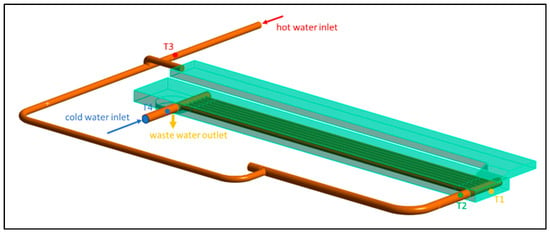
Figure 4.
Geometry of the model built using ANSYS FLUENT 2023 R2 software, with temperature monitoring positions marked.
A virtual copper layer (of 0.5 mm) was used as an interface between the wastewater and water in the heat exchanger; this represented the copper pipes used in the design to symbolize the wall. Heat transfer through the wall can be calculated manually in stationary conditions without turbulent flow. However, the study of more complicated cases involving multilayered structures or complex designs requires the use of numerical simulations, as presented, for example, by Volodymyr Brazhenko et al. [37], who used a Fourier equation to determine heat transfer through the wall. Heat transfer between cold and warm water is calculated within the solver, with the rest of the walls being treated as adiabatic. This approach gives a close approximation to actual conditions. During the shower, the linear sink was enclosed; in addition, the body of the heat exchanger was made of polyethylene, which is a good thermal isolator. Finally, the temperature in the cubicle was elevated and close to the mixed-water temperature.
Second-order tetrahedral (TET10) mesh elements were used for geometry discretization (Figure 5). Ultimately, the model consisted of 5,636,425 elements and 10,770,810 nodes. Mesh-quality metrics were monitored to meet the ANSYS best-practice requirement that orthogonal quality should remain above 0.1 and skewness below 0.95. These values were equal to 0.12 and 0.9, respectively, with average values of 0.8 for orthogonal quality and 0.19 for skewness. To capture the near-wall behavior of the flow, the mesh was densely concentrated to represent the boundary layer (Figure 6). This is particularly important in the case of air flows which are characterized by lower Reynolds numbers in comparison to water flows; such a laminar boundary layer can significantly decrease the convection rate. In the case of a water flow, this is usually less important; however, it was still applied in our model.
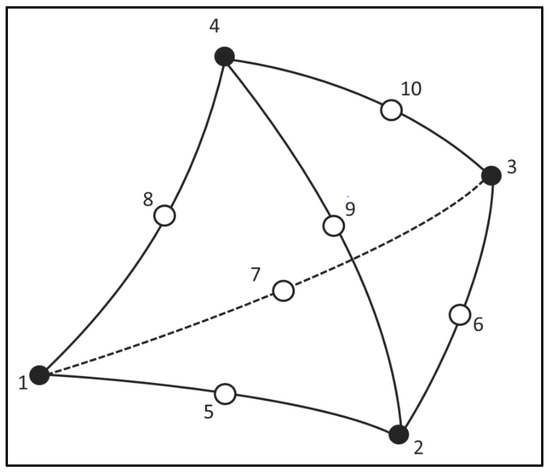
Figure 5.
Graphical representation of the TET10 element [38].
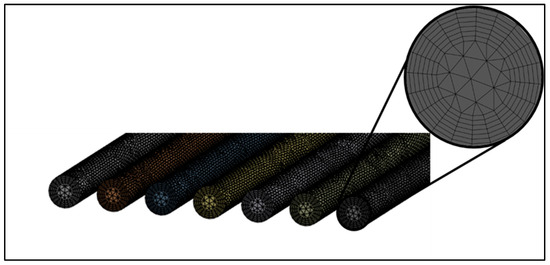
Figure 6.
Visible inflation near the wall of copper pipes precisely captures near-wall behavior.
Mass-flow inlet boundary conditions were used to represent the inflows of cold and hot water into the system. The amount of water and its temperature were determined based on average values obtained during the tests. Figure 7 presents water flow measurements obtained during the test, and values applied to the model. Significantly faster temperature increases can be observed for calculated temperature values in the case of both and . This was an effect of the use of hybrid initialization, which significantly improved convergence time, but simultaneously changed the initial temperature profile of the system in comparison to test values. Nevertheless, the achieved value at the plateau aligned very well with the measured values. A noticeable temperature increase may also be observed when considering the results of tests nos. 1, 2, and 3, successively. During the measurements, sufficient time between tests was not provided; as a result, the initial conditions were not identical. The numerical model aligned most closely with the first test performed. Overall, the results obtained from the numerical model were satisfactory. Based on the created model (benchmark) geometry, changes could be applied with a high level of confidence that results would precisely represent performance in a real-world environment.
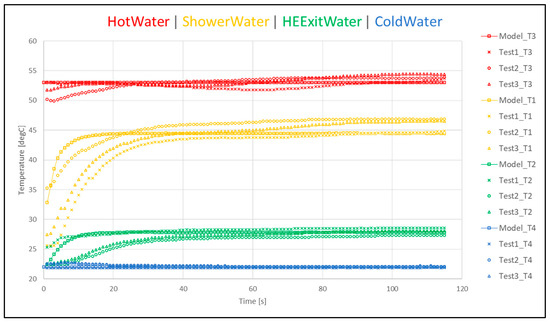
Figure 7.
Water flow measurements during experiment, and values applied to the model.
4. Coil-Design Heat Exchanger
A heat exchanger with a coil design was used to maximize the effective area of the heat exchanger and, thus, positively impact the turbulence intensity of the wastewater flow. The final geometry (Figure 8) was a result of a feasibility study carried out by a design team at the Institute of Aviation.
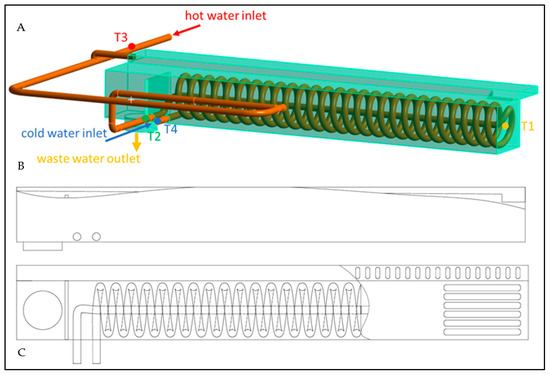
Figure 8.
Coil-design heat exchanger. (A) The model used in FEM simulation; (B) front view of the heat exchanger; (C) top view of heat exchanger where the coil shaped pipes and cover can be seen.
The coil was adjusted to maximize the heat transfer area while reducing the helical-line curvature radius, thereby maintaining a compact design. Initially, identical boundary conditions were applied to the coil-design heat exchanger model. Calculated temperature values for the new model are presented together with a baseline in Figure 9. The higher the Nusselt number, the better the heat transfer because the flow is more turbulent. Mishra [39] reported that a 10:1 ratio of helical coil diameter to pipe diameter resulted in a flow with an optimal character. Additionally, Farhadi et al. [40] presented results which indicated that both the overall heat transfer coefficient and the pressure drop increased with higher coolant flow rates and greater curvature ratios of the helical coil. For the present study, we adopted a helical coil with a curvature ratio of 7.5, representing a compromise between good performance and functionality.
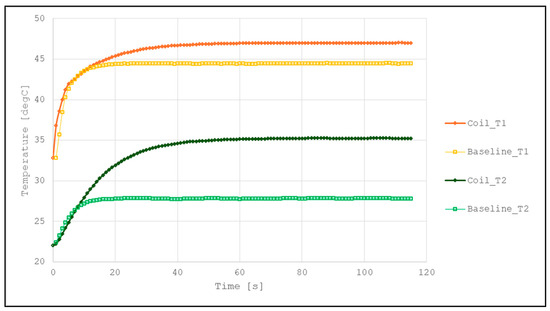
Figure 9.
Exit temperatures and mixed-water temperatures of baseline and coil-design heat exchangers. T1—inlet temperature; T2—exit temperature.
Next, the cold- and hot-water flow rates were modified to obtain temperatures at the inlet to the linear sink (mixed water), which were identical to the values from the benchmark, to check how much hot-water savings could be expected using the new design. Table 3 presents a comparison of average hot- and cold-water flows for three cases—no HE, the baseline HE design, and the coil HE design—in which a mixed-water temperature of 44 °C was obtained. A temperature plot with a comparison of the reduced hot-water flow input and water flow rate is presented in Figure 10.

Table 3.
Comparison of baseline and coil-design heat exchangers’ hot- and cold-water flows.
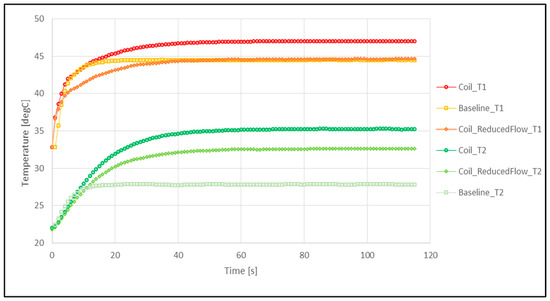
Figure 10.
Comparison of baseline and coil-design heat exchangers’ exit and mixed-water temperatures with reduced water flow. T1—inlet temperature; T2—exit temperature.
Minerals such as calcium, magnesium, and iron can all be found in water. Soap molecules may react with those minerals and form insoluble compounds such as calcium stearate. Over time, these compounds can accumulate on the surfaces of copper pipes, causing the build-up of an insulating layer which adversely affects the efficiency of heat exchangers. The thermal conductivity of such a layer can vary, depending on the size, temperature, and composition of particles, but is generally within a range of 0.1–0.5 W/mK. For the purposes of the present study, a rate of 0.3 W/mK was assumed. To fully understand the negative impact of insulation layer accumulation on copper pipes, a long-term measurement campaign is being planned. However, our estimation was based on the numerical model. A calcium stearate layer with a thickness in a range from 50 to 1000 μm was introduced into the model so that its impact on heat exchanger efficiency could be evaluated. The results are presented in Figure 11.
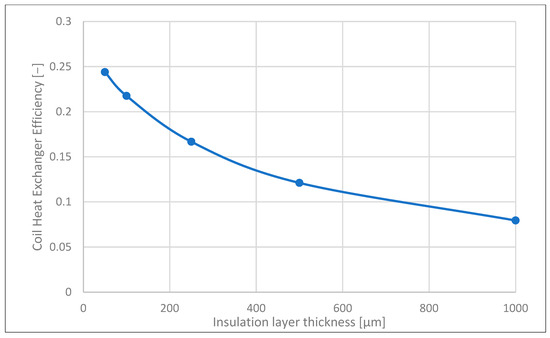
Figure 11.
Impact of a calcium stearate layer of varying thickness on heat exchanger efficiency.
5. Discussion
The most accurate metrics of efficiency for a heat exchanger such as that described above may be calculated using Equation (3), as follows:
where .
In the present study, the impact of temperature on the specific heat capacity of water ( was found to be negligible. For baseline and coil designs, obtained efficiency values were 0.14 and 0.27, respectively. In addition, and as shown in Table 3, savings in hot water of 6.1% and 16.7%, for baseline and coil designs, respectively, were achieved. In Figure 8 of third test, it can be observed that the heat exchanger water reached the target temperature much more quickly in the third test. This was probably caused by the wrong process (not enough time) being used to cool the experimental device; hence, the initial temperature of the heat exchanger was higher.
In the present study, we mainly focused on the steady-state performance of the heat exchanger. Thus, model convergence time was preferred over the ideal transient phase reconstruction. This is apparent in Figure 8, where the model temperature can be seen to achieve its final value faster than it would in reality. Transient-behavior studies of such devices should deliver improved results in the future, perhaps by the use of a standard initialization method supported by patching and a lower time-step size.
The experiments in the present study were conducted in an environment where a cold-water supply delivered water with a temperature of 22 °C. However, this is not a typical value for Polish households. In Poland, the temperature of cold water tends to oscillate around 10 °C. Using a numerical approach, the design of the coil-design heat exchanger could also be evaluated, under different operational conditions, using the colder temperature of the water flow at the inlet to obtain the same mixed-water temperature of 44 °C.
6. Conclusions
The goal of the present study was to provide a comprehensive understanding of how numerical solutions can enable the design of heat exchangers with optimal thermal efficiency, leading to a significantly lower consumption of hot water in households. To achieve our study aims, we combined a practical approach with numerical modelling and experiments.
An increase in heat-exchanger efficiency from a value of 0.14 to a value of 0.27 was achieved by a change in geometry. In addition, the impact of shower sediments on heat efficiency was simulated. We found that a layer with a thickness of just 200 µm reduced the efficiency of the exchanger by 11 percentage points.
The heat exchanger still needs to be experimentally tested for soap deposition on the copper pipes; the impact of such deposition on heat-exchanger efficiency over longer periods of weeks and months should be considered. The effectiveness of sodium hydroxide and sodium hypochlorite as cleaning chemicals also needs to be evaluated.
In future studies, the test procedure may be improved to increase the time intervals between consecutive tests. Access to computational cluster-geometry optimization might help to improve the efficiency of an already well-validated model. Nonetheless, at this stage of development, this might not be necessary. In our experiments, the CFD simulation error was found to be 0.7 °C, or 4%. Previous similar analyses have produced errors ranging from 2 to 10%, sometimes even as high as 36% [40]. F. C. C. Galeazzo et al. carried out a CFD plate heat exchanger simulation using the k-e model and also obtained a low error value of 8% [41]. Error rates might also be reduced by the use of more elements; for instance, Altwieb et al. [36] reduced error by eight times (4.9% to 0.6%, with a single parameter) using triple discretization.
The cost of electricity was determined on the basis of the average total cost of 1 kWh in Poland in 2024 for the G11 tariff group of 0.8–1.23 PLN/kWh [42]. According to a report from the Polish Statistical Office [10], the average household annually uses 53 m3 of hot water. European statistics [43] indicate that the production of every kWh of electrical energy in Poland involves 0.633 kg of CO2 emissions. Detailed calculations are presented in Table 4.

Table 4.
Calculations of savings and reductions in CO2 emissions.
A reduction of 0.167 ( in hot-water consumption, assuming a 0.6 per capita frequency of daily showers (a), four people in an average Polish family (fm), a seven-minute shower duration, (t), a mass flow of 7.56 L/min (, and a cost of EUR 11.15/1 m3 of hot water in Warsaw (), results in an annual saving of EUR 86 (. Detailed calculations are presented in Table 4. Moreover, CO2 emissions would be reduced by 192 kg every year ( Another approach that could be easier involves calculating the amount of energy needed to heat the water that was saved. If we take the average European price for 1 to be EUR 0.2525 () [42] and assume carbon emissions produced by electricity generation to be 0.292 kg/ [44], this leads to a saving of 76 kg in CO2 emissions and a reduction in cost of EUR 66 annually. Using the same method with Polish data for 2022, the savings are 192 kg of CO2 ( and EUR 38 . This second method assumes 100% energy conversion from electricity to hot water.
Our analysis shows that the cost of purchasing such a device would be recouped over a period of 2–3 years. Selcuk [24] suggests a figure of 2 years for a four-person family. Zaloum [45] calculates a payback time of 5 years, assuming a 30-year life period. We estimate the cost of the new device to be 120% that of a standard device. A similar conclusion was reached by Spriet [6], who showed that hot-water consumption could be reduced by 7.6–22%, but with an installation cost increased to 120–130%.
It is unquestionably economically and ecologically viable for heat to be recovered from wastewater; however, the equipment used for this purpose must be subject to potential redesign on an ongoing basis.
Author Contributions
Conceptualization, D.M. (Damian Maciorowski), M.J.S. and D.M. (Danuta Miedzinska); methodology, D.M. (Damian Maciorowski), M.J.S. and D.M. (Danuta Miedzinska); software, D.M. (Damian Maciorowski); validation, D.M. (Damian Maciorowski) and M.J.S.; investigation, D.M. (Damian Maciorowski) and M.J.S.; resources, D.M. (Damian Maciorowski) and M.J.S.; data curation, D.M. (Damian Maciorowski) and M.J.S.; writing—original draft preparation, D.M. (Damian Maciorowski) and M.J.S.; writing—review and editing, D.M. (Damian Maciorowski), M.J.S. and D.M. (Danuta Miedzinska); supervision, D.M. (Danuta Miedzinska); project administration, D.M. (Danuta Miedzinska); funding acquisition, D.M. (Danuta Miedzinska). All authors have read and agreed to the published version of the manuscript.
Funding
The paper was written as part of the implementation of the university research grant No. 22-716.
Data Availability Statement
Data will be made available on request.
Conflicts of Interest
The authors declare no conflicts of interest.
References
- Hervás-Blasco, E.; Navarro-Peris, E.; Corberán, J.M. Closing the residential energy loop: Grey-water heat recovery system for domestic hot water production based on heat pumps. Energy Build. 2020, 216, 109962. [Google Scholar] [CrossRef]
- Gercek, M.; Durmus Arsan, Z. Energy and environmental performance-based decision support process for early design stages of residential buildings under climate change. Sustain. Cities Soc. 1019, 48, 101580. [Google Scholar] [CrossRef]
- McNabola, A.; Shields, K. Efficient drain water heat recovery in horizontal domestic shower drains. Energy Build. 2013, 59, 44–49. [Google Scholar] [CrossRef]
- Stec, A.; Kordana, S. Analysis of profitability of rainwater harvesting, gray water recycling and drain water heat recovery systems. Resour. Conserv. Recycl. 2015, 105, 84–94. [Google Scholar] [CrossRef]
- Prajapati, S.; Fernandez, E. Residential load management with gray water recycling to maximize rooftop solar PV usage. Energy Sources Part A Recovery Util. Environ. Eff. 2019, 1–13. [Google Scholar] [CrossRef]
- Spriet, J.; McNabola, A. Decentralized drain water heat recovery from commercial kitchens in the hospitality sector. Energy Build. 2019, 194, 247–259. [Google Scholar] [CrossRef]
- Wong, L.T.; Mui, K.W.; Guan, Y. Shower water heat recovery in high-rise residential buildings of Hong Kong. Appl. Energy 2010, 87, 703–709. [Google Scholar] [CrossRef]
- Birben, N.C.; Uyguner-Demirel, C.S.; Bekbolet, M. Photocatalytic Removal of Microbiological Consortium and Organic Matter in Greywater. Catalysts 2016, 6, 91. [Google Scholar] [CrossRef]
- Boano, F.; Caruso, A.; Costamagna, E.; Ridolfi, L.; Fiore, S.; Demichelis, F.; Galvão, A.; Pisoeiro, J.; Rizzo, A.; Masi, F. A review of nature-based solutions for greywater treatment: Applications, hydraulic design, and environmental benefits. Sci. Total Environ. 2020, 711, 134731. [Google Scholar] [CrossRef]
- Statistics Poland. Energy Consumption in Households in 2021. Available online: https://stat.gov.pl/obszary-tematyczne/srodowisko-energia/energia/zuzycie-energii-w-gospodarstwach-domowych-w-2021-roku,2,5.html (accessed on 25 January 2024).
- Slys, D.; Kordana, S. Financial analysis of the implementation of a Drain Water Heat Recovery unit in residential housing. Energy Build. 2014, 71, 1–11. [Google Scholar] [CrossRef]
- Paepe, M.D.; Theuns, E.; Lenaers, S.; Loon, J.V. Heat recovery system for dishwashers. Appl. Therm. Eng. 2003, 23, 743–756. [Google Scholar] [CrossRef]
- Hua, L. Heat Exchanger Development for Waste Water Heat Recovery. Master’s Thesis, University of Canterbury, Canterbury, UK, 2005. [Google Scholar]
- Spriet, J.; Hendrick, P. Wastewater as a heat source for individual residence heating: A techno-economic feasibility study in the Brussels Capital Region. J. Sustain. Dev. Energy Water Environ. Syst. 2017, 5, 289–308. [Google Scholar] [CrossRef]
- Li, F.; Zheng, G.; Tian, Z. Optimal operation strategy of the hybrid heating system composed of centrifugal heat pumps and gas boilers. Energy Build. 2013, 58, 27–36. [Google Scholar] [CrossRef]
- Chae, K.-J.; Kang, J. Estimating the energy independence of a municipal wastewater treatment plant incorporating green energy resources. Energy Convers. Manag. 2013, 75, 664–672. [Google Scholar] [CrossRef]
- Song, Y.; Yao, Y.; Ma, Z.; Na, W. Study of performance of heat pump usage in sewage treatment and fouling impact on system. China Renew. Energy Resour. A Greener Future 2006, VIII-8-2, 1–7. [Google Scholar]
- Zhou, W.Z.; Li, J.X. Sewage heat source pump system’s application examples and prospect analysis in China. In Proceedings of the International Refrigeration and Air Conditioning Conference, West Lafayette, IN, USA, 12–15 July 2004. [Google Scholar]
- Incropera, F.P.; Bergman, T.L.; Lavine, A.S.; Dewitt, D.P. Fundamentals of Heat and Mass Transfer, 7th ed.; John Wiley & Sons: Jefferson City, MO, USA, 2011. [Google Scholar]
- Mazur, A.; Stec, A.; Słyś, D. Horizontal Shower Heat. Exchanger. Patent No. P.234930, 27 February 2018. [Google Scholar]
- Mazur, A.; Słuś, D.; Dziopak, J. Horizontal Heat. Exchanger. Patent No. P.423030, 2 October 2017. [Google Scholar]
- Deng, Z.; Mol, S.; Hoek, J.P. Shower heat exchanger: Reuse of energy from heated drinking water for CO2 reduction. Drink. Water Eng. Sci. 2016, 9, 1–18. [Google Scholar] [CrossRef]
- Sudirman; Sudana, I.M.; Ardita, I.N.; Baliarta, I.N.G. Drain water heat recovery horizontal for energy conservation and reduction of CO2 emissions. J. Phys. Conf. Ser. 2019, 1450, 012097. [Google Scholar] [CrossRef]
- Selcuk, S.; Eljetlawi, I.A.M. The experimental study of thermal energy recovery from shower greywater. Energy Sources Part A Recovery Util. Environ. Eff. 2021, 46, 3032–3044. [Google Scholar] [CrossRef]
- Ramadan, M.; Khaled, M. Recovering heat from shower water—Design calculation and prototype. In Proceedings of the International Conference on Renewable Energies for Developing Countries 2014, Beirut, Lebanon, 12 March 2014. [Google Scholar] [CrossRef]
- EN 12831-3:2017; Energy Performance of Buildings—Method for Calculation of the Design Heat Load—Part 3: Domestic Hot Water Systems Heat Load and Characterization of Needs, Module M8-2, M8-3. European Standard: Brussels, Belgium, 2017.
- Bertrand, A.; Aggoune, R.; Maréchal, F. In-building waste water heat recovery: An urban-scale method for the characterization of water streams and the assessment of energy savings and costs. Appl. Energy 2017, 192, 110–125. [Google Scholar] [CrossRef]
- EN 806-2:2005; Specification for Installations Inside Buildings Conveying Water for Human Consumption—Part 2: Design. European Standard: Brussels, Belgium, 2005.
- Kordana, S.; Pochwat, K.; Słyś, D.; Starzec, M. Opportunities and Threats of Implementing Drain Water Heat Recovery Units in Poland. Resources 2019, 8, 88. [Google Scholar] [CrossRef]
- Vaičiūnas, J.; Geležiūnas, V.; Valančius, R.; Jurelionis, A.; Ždankus, T. Analysis of drain water heat exchangers and their perspectives in Lithuania. J. Sustain. Archit. Civ. Eng. 2016, 17, 15–23. [Google Scholar] [CrossRef]
- Bhutta, M.M.A.; Hayat, N.; Bashir, M.H.; Khan, A.R.; Ahmad, K.N.; Khan, S. CFD applications in various heat exchangers design: A review. Appl. Therm. Eng. 2012, 32, 1–12. [Google Scholar] [CrossRef]
- Kanaris, A.G.; Mouza, A.A.; Paras, S.V. Flow and heat transfer prediction in a corrugated plate heat exchanger using a CFD code. Chem. Eng. Technol. 2006, 29, 923–930. [Google Scholar] [CrossRef]
- Kharat, R.; Bhardwaj, N.; Jha, R.S. Development of heat transfer coefficient correlation for concentric helical coil heat exchanger. Int. J. Therm. Sci. 2009, 48, 2300–2308. [Google Scholar] [CrossRef]
- Ansys Fluent Theory Guide; Release 2021 R2; ANSYS Inc.: Canonsburg, PA, USA, 2021.
- Venczel, M.; Árpád, V. Introduction to Design and Analysis of Torsional Vibration Dampers in Vehicle Industry. Int. J. Eng. Manag. Sci. 2019, 4, 310–324. [Google Scholar]
- Altwieba, M.; Kubiak, K.J.; Aliyuc, A.M.; Mishrac, R. A new three-dimensional CFD model for efficiency optimization of fluid-to-air multi-fin heat exchanger. Therm. Sci. Eng. Prog. 2020, 19, 100658. [Google Scholar] [CrossRef]
- Brazhenko, V.; Qui, Y.; Cai, J.; Wang, D. Thermal Evaluation of Multilayer Wall with a Hat-Stringer in Aircraft Design. Stroj. Vestn.-J. Mech. Eng. 2022, 68, 635–641. [Google Scholar] [CrossRef]
- Maas, S.; Ellis, B.; Rawlins, D.; Weiss, J. Finite Element Simulation of Articular Contact Mechanics with Quadratic Tetrahedral Elements. J. Biomech. 2016, 49, 659–667. [Google Scholar] [CrossRef] [PubMed]
- Mishra, T.N. Modeling and CFD Analysis of Tube in Tube Helical Coil Heat Exchanger. Int. J. Sci. Res. 2022, 12, 26–39. [Google Scholar] [CrossRef]
- Farhadi, S.; Shekari, Y.; Omidvar, P. Numerical and experimental investigation of laminar and turbulent convective heat transfer in a coiled flow reverser with twisted tape insert. Int. J. Therm. Sci. 2024, 197, 108781. [Google Scholar] [CrossRef]
- Polish Energy Distrubutor. Available online: https://www.tauron-dystrybucja.pl/kalkulator-zuzycia-pradu (accessed on 20 February 2024).
- Galeazzoa, F.C.C.; Miurab, R.Y.; Gutc, J.A.W.; Tadinic, C.C. Experimental and numerical heat transfer in a plate heat exchanger. Chem. Eng. Sci. 2006, 61, 7133–7138. [Google Scholar] [CrossRef]
- Eurostat. Electricity Prices by Type of User. Available online: https://ec.europa.eu/eurostat/databrowser/view/ten00117/default/table (accessed on 22 June 2024).
- Carbon Intensity of Electricity Generation. Available online: https://ourworldindata.org/grapher/carbon-intensity-electricity (accessed on 22 July 2024).
- Zaloum, C.; Lafrance, M.; Gusdorf, J. Drain Water Heat Recovery Characterization and Modeling; Final Report Revision 1; Sustainable Buildings and Communities Natural Resources: Ottawa, ON, Canada, 2007. [Google Scholar]
Disclaimer/Publisher’s Note: The statements, opinions and data contained in all publications are solely those of the individual author(s) and contributor(s) and not of MDPI and/or the editor(s). MDPI and/or the editor(s) disclaim responsibility for any injury to people or property resulting from any ideas, methods, instructions or products referred to in the content. |
© 2024 by the authors. Licensee MDPI, Basel, Switzerland. This article is an open access article distributed under the terms and conditions of the Creative Commons Attribution (CC BY) license (https://creativecommons.org/licenses/by/4.0/).